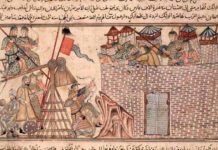North Korea was a country in disarray during the 1990s, shorn of Soviet support the Pyongyang regime struggled to feed its population.
During the 1990s North Korea underwent more destabilising changes than during the first four decades of its history. Its economy, which for a long time was ahead of the South’s, began to stagnate during the 1960s, beginning a slow and inexorable decline during the 1980s, before being sent into freefall by the collapse of the Soviet Bloc and the disappearance of Comecon, the Socialist common market.
North Korea and Comecon
Within Comecon, North Korea was able to trade its exports for petrol, coal and other products including rice and grains at favourable tariffs. The post-Cold War world in which North Korea found itself at the beginning of the 1990s demanded an economy much more supple and less centralised than the Stalinist plans of production that the country had followed since its inception. North Korea was overcome by bureaucracy and inefficiency, and, because of the philosophy of Juche and its dogma of self-sufficiency the country was imprisoned in an aging and obsolete industrial infrastructure, which placed most importance on the Stalinist idea of heavy industry.
The country exported very few finished products: more than 80% of exports were raw materials like the abundant natural minerals such as coal, magnesium, gold, and iron ore, which implies that the industrial system was not working well enough to produce a surplus of goods. The arms that Pyongyang exports to developing countries are one of the rare exceptions and provide the regime with one of its only sources of hard currency. In fact, it is estimated that North Korean industry worked at best 50% capacity during most of the 1990s, because of the power shortages that the country suffered since it had to find hard currency to pay for its imports of petrol and coal.
North Korea’s Mechanised Agricultural Sector
The lack of oil to fuel the factories had a devastating effect on farming because North Korean agriculture was one of the most mechanised in Asia, reliant on enormous quantities of chemical fertiliser to encourage crop production throughout its mountainous, inhospitable terrain. Before the division of the peninsular, the North was the industrial heart of the country, whereas the South had been the centre of agricultural production, the ‘rice bowl’ of Korea.
The result of all these interior and exterior pressures was almost immediately felt: grain production fell by 12% in 1990 compared to the previous year. The harvest of 4.8 million tons represented a deficit of almost 1.6 million tons, taking into account the official daily ration of 700 grams. Even before the country was hit by a series of massive floods in the mid-1990’s it had become evident that the farming sector was experiencing difficulties, since the government had already reduced the food ration in 1987. The food shortages did not begin at the moment of the first floods, but was the result of a rapid decline in industrial and agricultural capacity, caused by a massive fall in imports, specifically petrol which had hitherto been heavily subsidised by the USSR, at the beginning of the 1990’s.
North Koreas Bad Harvests
In response to this crisis the central government launched a campaign in 1991, calling for the populace to restrict themselves to just two meals per day in order to ration the available stockpile of food. So dire had the situation become by the time of this ‘patriotic’ appeal, that a large number of North Koreans were already surviving on a single, meagre meal per day. In 1992 and 1993 grain production fell slightly compared to 1991, with harvests of around 4.5 million tons recorded for each of these years.
Following on from this series of bad harvests the central government announced that the 3rd seven year plan had failed to reach its objectives, the first public admission of economic difficulties. As a result state rations, on which 61% of the population were dependant for most of their food, were again reduced which meant that an average citizen received a mix of just 400 grams of rice and grains per day, whereas a soldier received between 600 and 700 grams. Additionally, from 1992 food distribution in the north-east of the country became less frequent and was finally suspended two years later. It appears that Pyongyang, confronted by the reality that it was impossible to feed the entire population with their pitiful food reserves, took the decision to completely exclude this region – which is militarily and economically the least important in the country – from the public distribution system.
North Korean State Rations Reduced
Logically, this region, and in particular the city of Hamhung, was most affected by the famine, and its inhabitants begun to feel its effects well before the rest of the country. 1995 brought more misery for the country, with heavier than usual rainfall causing widespread flooding and convincing the government to appeal to the World Food Program for aid. This natural disaster, along with similar flooding the following year and a drought in 1997 combined to reduce North Korea’s harvests to a perilously low level; consequently, the rationing system continued to encounter grave difficulties and daily rations were further reduced to 200 grams per person. In 1996 the central government, realising that central planning was too cumbersome and bureaucratic a tool for dealing swiftly with the famine, decided to decentralise the rationing system and transferred authority to individual counties.
Given that Pyongyang is the official window onto the country and all the elite live there it was largely spared the effects of the famine, but the lack of electricity which paralysed the country’s infrastructure was evident with the capital suffering frequent blackouts.
References
- Pierre Rigoulet, “Corée du Nord, Etat voyou”, Paris, Buchet-Chastel, 2003.
- Philippe Grangereau, “Au pays du grand mensonge”, Le Serpent de Mer, Paris, 2001.
- Andrew Natsios, “United States Institute of Peace Report”, http://www.usip.org/pubs/specialreports/sr990802.html, 1999.








